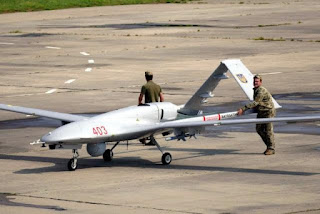
In the early days of the Russia-Ukraine conflict, Turkey's Bayraktar TB2 drones emerged as a symbol of hope for Ukraine's defense forces and were hailed as the future of warfare. These drones gained fame as videos and reports showcased their successful strikes against Russian tanks, armor, and patrol boats, capturing the imagination of many and even inspiring a viral folk song. However, the tides have turned, and experts now reveal that these once-revered drones have suffered a significant decline in effectiveness, with the majority being shot down and the remainder relegated to reconnaissance tasks.
Samuel Bendett, an analyst and expert in unmanned and robotic military systems at the Center for Naval Analyses, explains that the TB2 drones proved successful in the early stages of the conflict due to the absence of sophisticated air and electronic warfare defenses. As relatively slow and low-flying unmanned aerial vehicles (UAVs), they became susceptible targets for well-organized air defense systems, as witnessed in conflicts such as Libya and Nagorno-Karabakh.
Russia, quick to adapt, bolstered its electronic warfare capabilities, effectively countering the Ukrainian drones. Bendett points out that once the Russian military strengthened its defenses, it successfully downed numerous TB2 drones. Despite Ukraine's claim of receiving 50 TB2 drones since the invasion began, by the end of 2022, these drones had largely vanished from the battlefield.
Lieutenant-General Andrey Demin, the commander of the Russian air defense force, boasted that Russian forces destroyed over 100 TB2 drones in April alone. Presently, Ukraine primarily utilizes the TB2s for intelligence, surveillance, and reconnaissance purposes, as opposed to offensive operations.
Bendett notes that Ukrainian forces are employing the advanced optics and sensors of the drones to guide other UAVs for attacks, all while staying out of the range of Russian air and electronic warfare systems. However, recent assessments suggest that Russia has gained the upper hand in the drone war, successfully downing approximately 10,000 Ukrainian drones each month. The use of electronic warfare has become a critical component of Russia's tactics, contributing to the substantial losses suffered by Ukrainian drones.
According to a report released by the UK's Royal United Services Institute (RUSI), the Russian military initially faced difficulties during the invasion, with poor morale and ineffective use of heavy armor and air-force attacks. However, it swiftly adapted to Ukraine's pushback, bolstering its capabilities and improving its performance. The report emphasizes that although Ukraine still holds the initiative, complacency must be avoided as the Russian military continues to adapt.
The rise and fall of Ukraine's Bayraktar TB2 drones serves as a cautionary tale about the evolving nature of modern warfare. It highlights the significance of adaptability and the crucial role that electronic warfare plays in countering unmanned aerial threats. As the conflict persists, both sides continue to refine their strategies and tactics, ensuring that the drone war remains a pivotal aspect of the Russia-Ukraine conflict.



